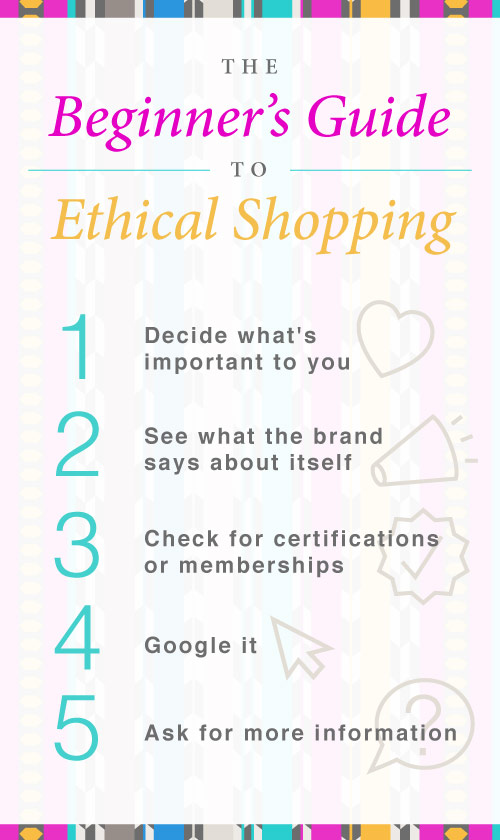A friend recently asked me how to get started shopping ethically: How can you tell if a brand is ethical? Where do you go? What do you look for? Looking back at my own process of becoming a more ethical consumer, I came up with some basic strategies you can use to gauge the ethics of a brand and ultimately decide if you want to support them.

1. Decide what’s important to you
Do you care primarily about workers’ rights? The environment? Both? Use your personal priorities to guide your search. No brand is perfect, so it helps to know your must-haves as well as areas you would be comfortable compromising.
When I first started changing my shopping habits, working conditions and fair wages were my primary criteria. Human rights are still my main focus, but as I continue to learn more about how the environment is intertwined with human rights, lower-impact manufacturing processes and materials are now important to me as well.
2. See what the brand says about itself
I’ve found this in many different locations on brand websites. Good places to start are the About section, the FAQ page, anything labeled “Who We Are” or “Our Story,” or specific sections about sustainability or social responsibility. If a brand doesn’t mention a commitment to ethical or sustainable practices in any of these places, it’s a good bet that those things aren’t important to them. The more detailed and transparent a brand is about its practices, the better.
Note that most big mainstream brands have a lot of social responsibility- and sustainability-related content on their websites. Some are making real, positive progress, but I recommend not taking major brands solely at their word. Run a few strategic Google searches (see #4 below) to see if their media coverage lines up with their claims.
3. Check for certifications or memberships
There are many organizations that either certify ethical brands or products, or offer membership to brands who commit to following a certain set of principles. (Here is a rundown of some of the most well-known ethical certifications.) If a brand is certified by or a member of one of these organizations, the brand may post the organization’s logo on their website. Check in the About section or footer, or the brand may have a separate page called “Partners” or something similar.
Not all ethical companies are necessarily certified by or members of an ethical organization. However, looking for memberships and certifications is a great place to start if you’re overwhelmed by researching individual brands. Most organizations have directories of their members so you can easily find out who has met their standards. Seeing one of these logos can be a quick confirmation that a brand has met a certain baseline of ethical or sustainable practices.
4. Google it
If the brand you’re looking at doesn’t have any ethical certifications or memberships, try googling it alongside a few different words to see if people are writing about the brand in a positive or negative way. Here are some ideas:
- [brand name] sustainable (i.e. “H&M sustainable”)
- [brand name] ethical
- [brand name] sweatshop
- [brand name] living wage
- [brand name] labor
- [brand name] workers
- [brand name] [criteria that’s most important to you]
Look for articles that feature some investigation or analysis, rather than just press releases written by the brand itself. You may also be able to find if the brand is recommended as ethical or sustainable in a directory or shopping guide focused on those characteristics.
5. Ask for more information
If you can’t find the information you’re looking for on the brand’s website or through independent media coverage, send them an email and ask! You may not receive a response, but sometimes you will, and often the tone and depth of that response will be a clear indicator of whether the brand is truly committed to the values you care about or if they’re just using green catchphrases.
6. Give yourself time
Obviously, following all of these steps every time you need to buy something is a lot of work. Give yourself time to become familiar with certifications and what companies tend to say about themselves. Find a few brands you feel confident about and start there.
Your purchases may not be perfect at first. When I first began shopping consciously, I bought things from companies I probably wouldn’t choose to support now. Likewise, there are now companies I probably would support now that I wouldn’t have before, because I’ve been able to see their progress and commitment over time.
For an abundance of information and links about ethical shopping, check out our Resources page.

Thanks Julia! This is some great information. I appreciate you sharing all of this :)
Great post! Shared the ethical shopping love on Facebook. Thanks for putting this together.
Xx
Katie
How to Start Spending Ethically |
[…] resources provided by our planet…”) I remembered a post I wrote a few years ago called The Beginner’s Guide to Ethical Shopping, which focuses on how to evaluate the ethical qualities of a specific brand. While that information […]